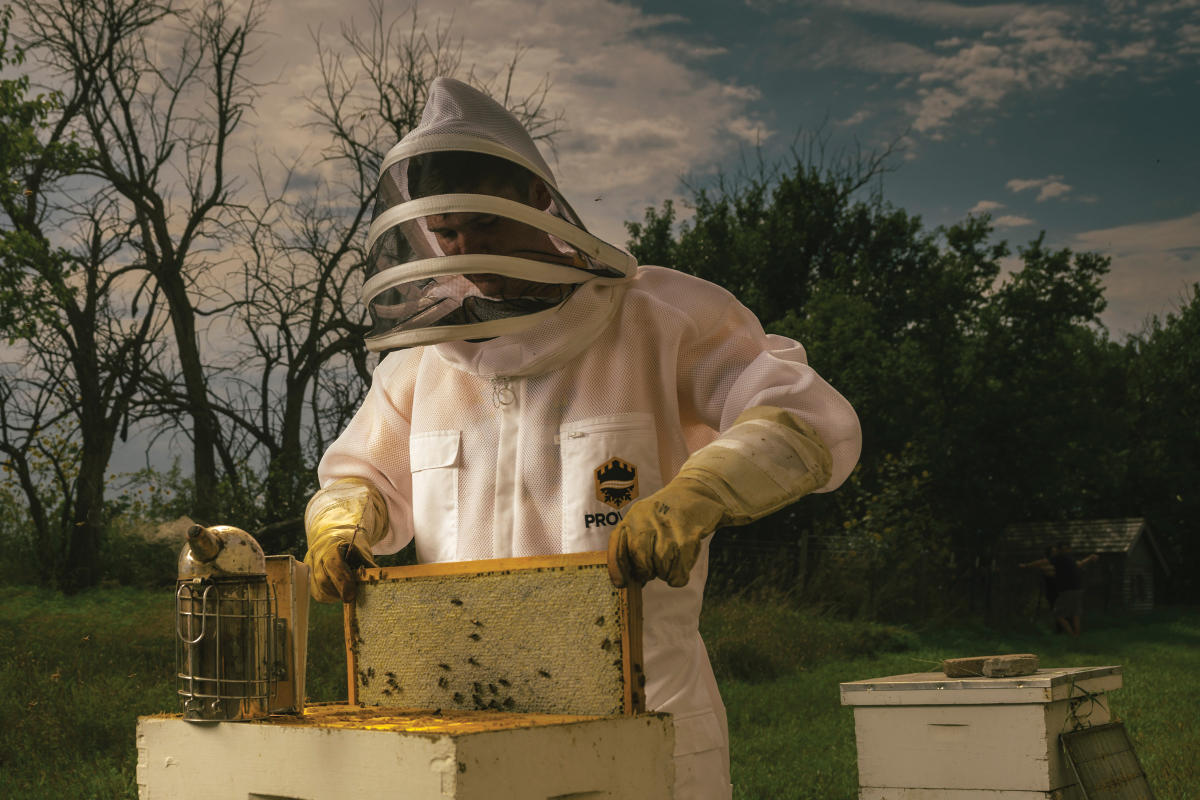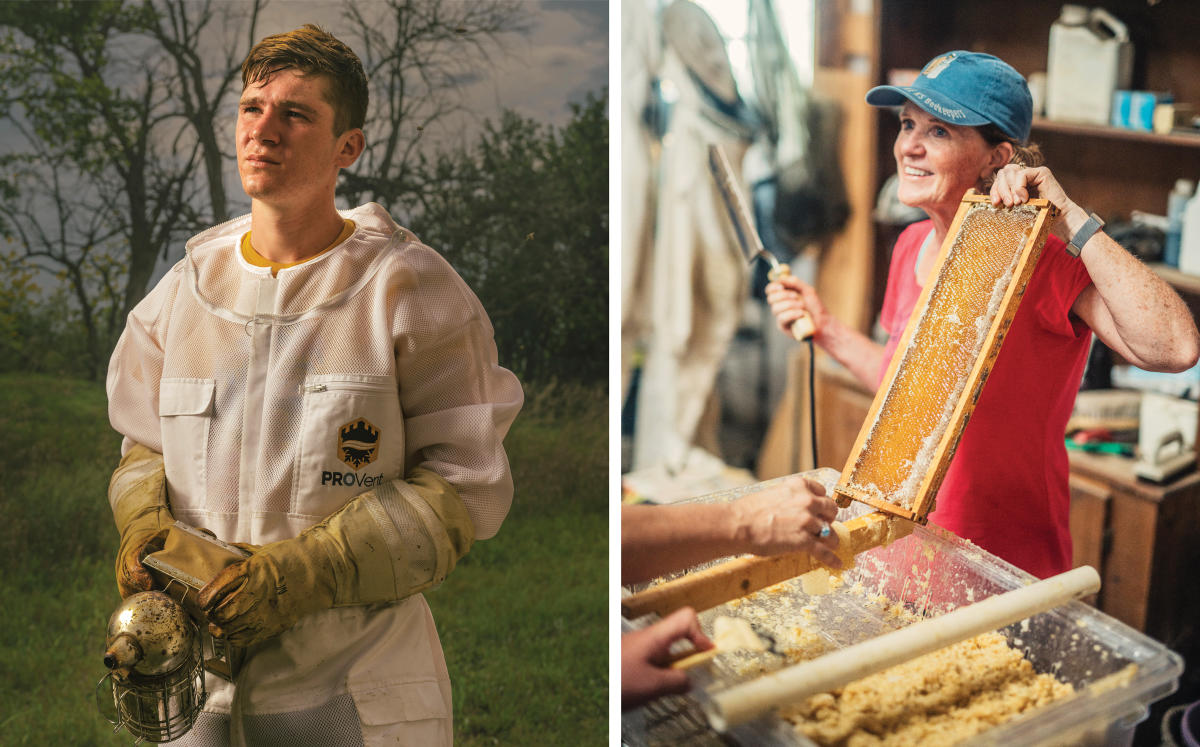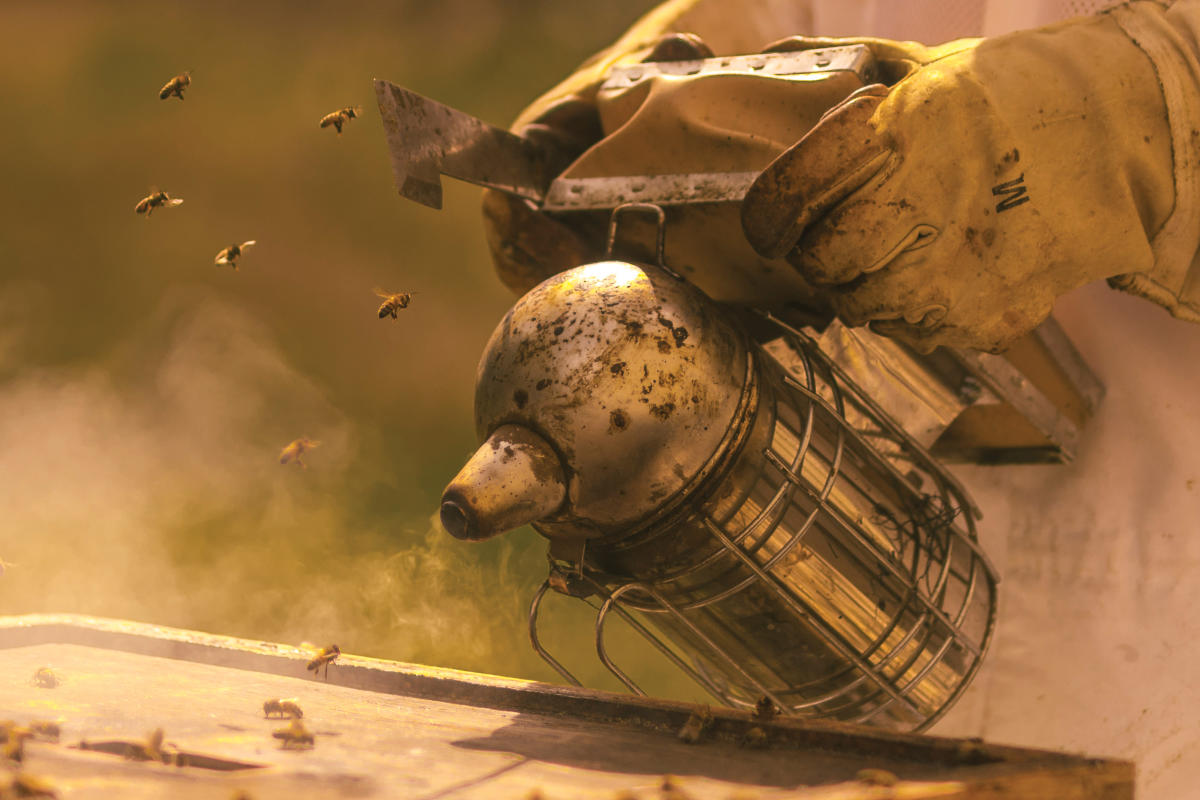 Photography by Justin Lister
Photography by Justin Lister
Working through his family farm, a Rogan Tokach hopes to reverse a statewide decline in honey production
Rogan Tokach’s fascination with bees began when he observed a hive at the Central Kansas Free Fair in Abilene. It was the summer before he entered the eighth grade, and Rogan remembers telling his mom that he wanted to start a hive on their property in rural Dickinson County.
“She bought me a copy of Beekeeping for Dummies and thought that would end the matter,” he recalls. Instead, it was just the beginning. Rogan, who is now a senior at Kansas State University majoring in agronomy with a minor in entomology, read the book from cover to cover and was even more intrigued.
That road from hive observer to bee scholar has been paved in golden honey, beginning with a scholarship from the Kansas Honey Producers Association (KHPA) that was awarded to Rogan and his sister, Sage. “We initially received a hive, two beekeeping suits, a smoker and other essential equipment,” Rogan says. “Our parents then bought us another hive for Christmas.”

Toward the end of high school, Rogan began recruiting others by working through 4-H and starting a club open to anyone in the community interested in beekeeping. The group provided potential hobbyists an opportunity to see if they would enjoy working with bees before they forked over the funds needed to start a colony. Three families were a part of that first group; all have since purchased their own hives and continue with beekeeping.
To fund the club, Rogan again turned to the KHPA, this time for a grant. They provided two hives, multiple suits and other needed equipment. Hives were placed on the grounds of Brown Memorial Park near Brown Memorial Home, a rural recreation park and senior housing facility south of Abilene. Brown’s Busy Beekeepers, still in operation, is now under the direction of Dr. Lisa Tokach, a veterinary clinician and Rogan’s mom. Club members check the hives about every two weeks and harvest honey each fall.
James Kellie, KHPA president, says clubs such as these are essential to his organization’s mission of educating people on the vital role honey bees and other pollinators play in the ecosystem and perhaps “light a spark for a future beekeeper or scientist that may help our plight with the honey bee.”
That “plight” refers to a drastic drop in wild bee and cultivated populations from disease and other factors. A report from the independent, nonprofit Bee Informed foundation found that Kansas lost some 43% of cultivated colonies from 2017–2018. According to statistics from the United States Department of Agriculture, there were 43,000 honey producing colonies in Kansas in 1978; that number had dropped to 17,000 by 1998. KHPA estimates there are now just around 7,000 colonies, producing 3/4 of a million pounds of honey.

A Kansas beekeeper for 43 years who has managed over 13,000 colonies, Kellie has noticed a definite change in the landscape of beekeeping. Pesticides, fungicides, and colony diseases play a role in the decline. But Kellie believes it is urban sprawl and changes in farming practices that have had the greatest impact, changes that have evolved over time. These include loss of pastures, planting of single crops versus rotation, and reliance on crops that do not need pollination.
Kellie points out that America’s commercial beekeepers are unable to produce all the honey that is demanded in this country, about two pounds per person per year. As a result, honey is imported, some from countries with few health regulations about what can be labeled as honey. Sometimes other ingredients such as rice syrup are added as filler. “It’s become a ‘buyer beware’ market,” Kellie says. The KHPA suggests that customers buy from local producers, whether commercial or hobbyist.
Farmers markets and grocery stores across the state carry an array of local honey, each with its own unique color and flavor. Each drop of the 20 gallons of honey harvested annually at the Tokach farm bears a taste of the neighboring alfalfa fields where the bees nourish themselves as they pollinate the plants. The Tokachs sell this honey under a “Honey for Heifer” label, with proceeds going to buy beehives for Heifer International, a global nonprofit that helps fight hunger and poverty.
“Bee the Change” is the motto Rogan adopted for his Honey for Heifer service project and a slogan that appears on jar labels. However, it seems it’s also a philosophy that has guided Rogan throughout his beekeeping adventures and continues to direct his future.
“My plans include studying the effects of pesticides and other problems that are causing declines in bee populations,” Rogan says. “I also plan to work with farmers to help develop and maintain environmental practices that keep bees alive in Kansas and across the nation.”
Taste of Honey in Kansas
Flavor, color and even aroma of honey vary depending on the nectar of flowers visited by bees and can be influenced by weather as well. Much like a wine taster would explain the flavor profile of wine, James Kellie, president of the Kansas Honey Producers Association and a beekeeper in Pawnee County, shares his observations about some of the most common taste influencers of Kansas honey:
- Alfalfa, grown predominantly in central and south central Kansas, produces light-colored honey under ideal weather conditions including enough rain; hot, dry conditions produce darker honey. No matter the final color, alfalfa produces a sweet honey that ranks high in popularity.
- Sweet clover, found predominantly in north central and western Kansas, provides honey with a light color and a distinct “pop” of sweetness.
- Dutch clover, found in urban yards and pastures, especially in northeast Kansas, produces lighter-colored honey with caramel undertones and a bit of a “zip” at the end.
- Wildflower fields, particularly those in the eastern part of the state, generally lead to honey with a menagerie of flavors that can create very “busy” taste sensations.
- Buckwheat, an agricultural plant grown throughout most of the state, creates darker honey with a robust, somewhat savory flavor that has a “bang” at the end.
- Smartweed, a wetland plant that grows during the autumn in wet ditches and fields throughout the state, creates dark honey with a strong, savory aroma and an “attention-getting” flavor—one that seems to be either loved or hated.




